Sourdough English Muffin Recipe
This post may contain affiliate links.
Sourdough English muffins are such a lovely little invention. They are tangy rounds of fermented dough with just enough nooks and crannies to hide butter and jam in.
And they are actually quite easy to make - you just have to be organised to give the dough enough time to ferment. This recipe uses an active and bubbly sourdough starter, however there is a variation for Sourdough Discard English Muffins further down.
English Muffins made with sourdough starter are fairly easy to put together. You basically mix the dough into a relatively smooth (yet sticky) dough and then leave it overnight to ferment.
If you have a bit more time, you can pop it in the fridge to ferment for up to 3 days. This little trick will ensure you don't over ferment the dough ... and you get that beautiful rounded sourdough tang that is so sought after with sourdough English muffins.

English Muffins Aren't Really English
Here's some trivia for you ... because I just love a bit of history. English muffins aren't actually English. In fact, they were invented in the US. And in England - they're called American muffins. Crazy right?
These crazy popular leavened muffins were actually invented by an Englishman in the US, New York City to be precise. If you're interested in more of the history of English Muffins, you can read all the info here.
How To Make Sourdough English Muffins
This sourdough English muffin recipe is quite simple. The process does take a few days due to the fermentation - but this is a good thing because your sourdough starter will make English muffins that are much easier to digest than store bought ones!
Ideally, you'll need an active sourdough starter, but discard will work (see notes on this further down). You might also like to turn this into a sourdough English muffin loaf.

Here's the basic process for making English Muffins with a sourdough starter:
- Add flour, milk, honey, salt and sourdough starter to a large bowl and mix together to form a sticky dough.
- Use wet hands or a dough scraper to gently knead the dough in the bowl. It will be sticky because of the hydration level, but it will form a dough.
- Cover the bowl and leave it to ferment on the kitchen counter (overnight is ideal as long as it's not too warm). You'll find the mixture will double in size.
- Once the dough has fermented, work you way around the bowl and bring the dough into a ball using stretch and folds.
- Leave the dough to rest for around 30 minutes.
- Now sprinkle a generous amount of corn meal onto your kitchen counter and ease the dough out on top of this.
- Gently roll the dough out to form a rectangle (you can use your hands if you like).
- Use a scone or biscuit cutter to cut rounds of dough out. I used a small glass dipped in flour to stop it sticking.
- Place the rounds onto a parchment lined tray dusted with cornflour.
- Leave them to rise for around an hour (they should be puffy and light).
- Heat a skillet or frying pan and dust with corn meal.
- Place 4 English Muffins into the skillet at once and cover. Cook on medium heat for around 6 minutes before flipping them and cooking on the other side.
- Once they've cooled a little, split them and spread with butter and jam!
Stages of Fermentation for Sourdough English Muffins

This image shows the dough when it's first mixed to how it looks when you've pulled it together into a ball after fermentation.
You can see that the dough has developed structure and smoothed out.
The bottom left shows the dough turned out onto the kitchen counter. You can see the beautiful gluten strands that have formed during fermentation.
The dough is still a little sticky at this stage, so corn meal is essential to keep it workable and if you have some cornmeal leftover, why not try these sourdough cornbread muffins.
If you are loving fermented breakfast treats, you might also like these overnight sourdough waffles.
The Secret To Good Sourdough English Muffins
Whether you're making sourdough English Muffins, or the regular variety - there's one thing that can make or bread a good muffin. You can't cut them!
Seriously, do not use a knife. To make sure you get maximum nooks and crannies, you need to split them with a fork.

Once they're cool, push a fork into the side of the muffin and keep going around the edge until it splits open.
This is called "fork split" and will ensure that there are lots of "gnarly" bits of dough that go crispy and brown when toasted. Trust me, it's a game changer!
You must ensure that they have cooled though - if you do it when they're too hot, the steam trapped inside will cause a gummy crumb (just like when you cut sourdough bread too soon).
Patience really is a virtue with sourdough!
Additional Tips
I like to make my English Muffins with active, fed sourdough starter. But if you have lots of discard to use up, you can use the discard instead (as long as it's not too old, up to a week is ok).
If you want to use your discard in this recipe, just use it instead of active starter and add a half teaspoon of commercial yeast to your mixture.
This will ensure that the dough rises enough. This is especially important if you're still building your starter as your discard won't have enough of a yeast colony yet.
Still follow the instructions below, they will work.
You might just find that it rises a bit faster with the commercial yeast, so you won't need to leave them to rise for so long. They will also ferment in the fridge if you use commercial yeast.
If you have a mature starter, I would recommend trying this recipe without commercial yeast. Because of the long ferment time, you might be pleasantly surprised - even with your discard!
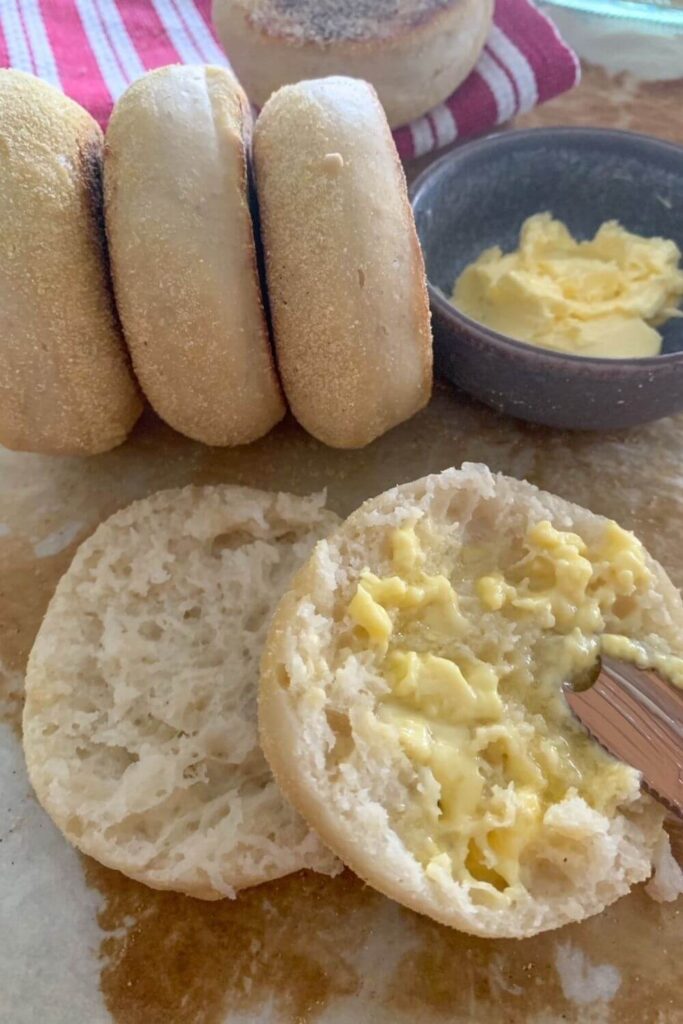
Making Sourdough English Muffins in Hot Weather
If the weather is warmer where you live, you might need to adjust things ever so slightly to ensure that you don't over ferment your dough.
It's not dissimilar to making traditional sourdough bread and making allowances for hotter temperatures.
Sourdough English Muffins are meant to be fermented for a longer period (it's what gives them the most amazing flavor), however if the ambient temperature in your home is over 28C you may need to use your refrigerator.
Once you've mixed the dough, allow it to ferment a little while on the kitchen counter - no more than an hour. Then place the dough into the fridge to ferment. It will take up to 3 days to fully ferment in the fridge.
If you do want to do an overnight ferment on the kitchen counter then you can reduce the amount of starter used. Drop it down to 100g of starter and use cold milk when you mix the dough.
These small tweaks will allow you to ferment the dough longer without over fermentation.
Serving Suggestions
There are lots of ways to enjoy these delicious sourdough English Muffins. While they are absolutely perfect toasted with lashings of butter, you might also enjoy some of these ideas:
- Toast and top with with homemade butter and sprinkle with cinnamon sugar. You might even like to serve them with this whipped honey cinnamon butter!
- Use them to make bacon and egg breakfast sandwiches. Don't forget the cheese! I love using this sourdough scrambled egg inside mine!
- Use them instead of burger buns for something different.
- Top with your favorite slices of cheese, fresh tomato and lashings of salt and pepper. This might just be one of my favorite lunches.
- Use them as mini pizza bases. My boys love making their own pizzas after school and these sourdough English muffins make it a breeze!
Notes & Substitutions
A few notes on ingredients and substitutions for sourdough English Muffins:
- You can use plain or all purpose flour instead of Bread or Baker's flour if you want to. But you may find that you need to reduce the amount of milk.
- If you have buttermilk on hand from making cultured butter or sweet cream butter, you can substitute some of the milk in this recipe with the buttermilk.
- You can use plain or all purpose flour to dust them with instead of corn meal, however you won't get the same cooked texture as you would with corn meal. Semolina is a better substitute than corn meal.
- You can keep the mixture for this sourdough English muffin recipe in the fridge for up to 3 days. Take it out of the fridge for around 30 minutes before you turn the dough out on the kitchen counter. Cut the rounds out and then let them rise before you cook them. It's better to cut them out with cooler dough and then let them warm up.
- Once you've cut them out, you can put the tray in the fridge for up to 24 hours. Let them come back to room temp before you cook them.
- Cooked English Muffins freeze really well. Store in ziploc bags and defrost and toast as you would like. For easy toasting, don't forget to fork split them before you freeze them.
If you're looking for another English inspired sourdough recipe, check out these sourdough crumpets.

Want More Recipes?
If you love this recipe, you might be interested in these ideas:
- Easy Sourdough Bagels
- Sourdough Hamburger Buns
- No Wait Sourdough Waffles
- Lemon Sourdough Muffins
- Apple & Cinnamon Sourdough Muffins

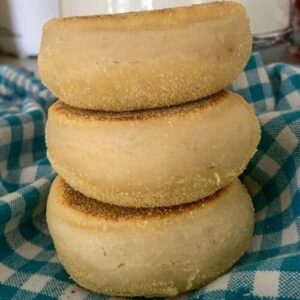
Sourdough English Muffins
Video
Equipment
- Mixing Bowl
- Cast Iron Skillet
- Biscuit Cutter
Ingredients
- 200 g Sourdough Starter fed and bubbly (reduce in warmer weather)
- 500 g Milk cold is better for overnight ferment
- 600 g Bread Flour
- 12 g Salt
- 20 g Honey you can use sugar if you want to
- 50 g Cornmeal for dusting
Instructions
- In a large glass bowl, mix together all of the ingredients, including your sourdough starter and bring it together to form a dough. The dough will be quite sticky. Gently knead the dough to bring it together.It's easy to do by hand in the bowl for less washing up, but if you prefer to do it in a stand mixer that's perfectly fine too.

- Once you have a dough formed, cover it in plastic wrap and set aside for around 12 hours to ferment at room temperature (see notes). You want the dough to rise (it doesn't need to double though). It should rise at least half in the bowl and become a smoother, structured dough (see the pics above of my dough). It's important that the dough maintains its gluten structure in order to be shaped into rounds.Just like traditional sourdough bread, you'll need to watch the dough, rather than the clock.

- Once you're happy with the dough, you can wet your hands and gently shape your dough into a rough ball by performing a set of stretch and folds. This will deflate the dough - but don't worry. Now leave the dough to rest for around 30 minutes.
- Dust your work surface with corn meal and then ease the dough out of the bowl. Sprinkle corn meal on the top of the dough too. Depending on how sticky your dough is, you might need to add some extra as you go along so keep it handy.

- Gently press the dough into a rectangle using your hands. Using a rolling pin, gently roll your dough to around ½ - ¾ inch thick. You don't want it too thick or your muffins will be doughy and take too long to cook in the middle. Using a biscuit cutter (or glass or plastic tumbler) gently cut out rounds of your dough and place them on a baking sheet lined with parchment paper and dusted with corn meal. Keep going until you can't cut any more. Then gather up the dough, roll it back out and repeat until you've used all the dough up.Cover the muffins with a tea towel and leave to rest for around 30 minutes.

- Heat a fry pan or skillet on the stove top. You want a medium heat - you don't want to burn the outside and leave the inside raw, so just keep an eye on them and adjust as you need to. Place 4 - 6 muffins in your skillet, cover with the lid and cook for around 6 minutes on each side. There is no need for oil or butter, the corn meal will protect them from sticking. Turn them over once you see the dough bubbling (they will be puffed up from the heat).Once they are golden on each side, take off the heat and allow to cool. Repeat the process until all of the muffins are cooked.

- Once they are cool, use a fork to split them and enjoy them with butter or toast them for extra golden goodness!

Notes
Nutrition


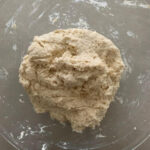
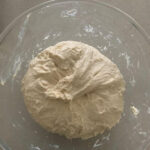
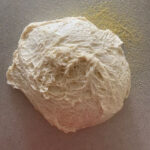
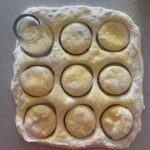
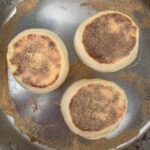
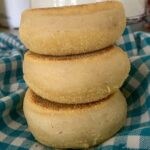



![Best Sourdough Easter Recipes [not just Hot Cross Buns]](https://www.pantrymama.com/wp-content/uploads/2024/01/BEST-SOURDOUGH-EASTER-RECIPES-11-1-768x1152.jpg)

What size biscuit cutter should be used to arrive at 24 muffins?
Through trial and error I realized that my ardent mills bread flour must be quite moist. I mixed up this recipe and the dough was more like batter and there was no way it could be kneaded. After an overnight ferment, I added at least 130 g more flour and it is still pretty sticky. In the future I will know to reduce the hydration level when using this flour.
I am so excited about this receipe Thanks for sharing. Can I substitute milk for a non dairy option like coconut or soy? Thanks
Not made this specific recipe but as an Englishman we definitely don’t call these American muffins, either just muffins or English muffins to differentiate with the cake kind.
Quick google shows that these are definitely from England with written recipes recorded from the 1700s
Can I substitute oat mile for the cow's milk?
Can non dairy milk be used in this recipe?
This was so easy to follow. I’m new to sourdough and appreciate bloggers like you that are so detailed. It helps me learn. They came out beautifully. Delicious. This is a keeper recipe.
I can’t wait to try this. I have made some successful sourdough hot cross buns following your recipe so I am confident they will work. However, I don’t know where you have gotten the information that these are called American Muffins in England? We call them English muffins. American muffins are the same thing you guys call muffins, and to be honest we just call them muffins haha x x x
My dough was very wet and sticky and difficult to work with. I note that someone else added 1/2 cup more flour to theirs for that reason. Will keep it in mind for next time!
Can these be made in the oven? If so, do you know the temperature and times? Thanks!
English Muffins are always baked on a skillet or pan - that's how they get their unique outer crust 🙂 I haven't tried baking them in the oven for this reason 🙂
If putting the dough in the fridge after the initial BF....when ready do you just take the dough out of fridge and roll out per usual or do you let the dough warm up a bit?
I made these using my sourdough discard. My dough was very wet and sticky. But I just did the best I could and I think they look like they turned out good in spite of the dough being very sticky. I weighed all ingredients so I don’t think my measurements were off. Any suggestions for future baking?
To be honest the British don’t call muffins, American muffins ever, sweet muffins maybe. English muffins were invited by an English man, Samuel Bath Thomas. In 1874 he emigrated to America from Plymouth, England to New York and started making thinner, pre-cut crumpets while he worked in a bakery.
Thank you for this recipe - it was straight forward, well explained, and delicious! After eight hours it had risen past 50% in my warm kitchen so I refrigerated for about 14 hours. After removing from refrigerator for 1 hour on counter I rolled out and cut into muffin size, waited 30 minutes and cooked as directed. They were wonderfully fermented and had those ragged holes that we covet in an English muffin! Patience is the key when cooking - low heat, covered and about 10 to 12 minutes for mine. Thank you!
These are wonderful!! I have a hard to please crew and everyone loved these "English" muffins LOL. So we went through them so fast I did not think to weigh them.....how much does each one weigh if I'm able to get 24 out of a single recipe?
I just made them and saw your comment. Six of mine weigh 846 grams, for an average of 141 grams each.
I love this recipe! Super easy and great tasting!
My dough was super sticky after the fermentation, hard to work with. Is this the way it should be?
This recipe produces the best nooks and crannies. As I continue making these, each time the high-hydration dough gets easier to work with. I find that doing a partial proof at room temp, 1-2 hours, then finishing in the refrigerator works best for my hot summers. The dough is easier to roll out and cut when it is still cold. Also, less sticking if I rub a little oil on the parchment paper for the final rise before cooking.
Thank you! My first ever attempt with sourdough and your instructions were so helpful!
I’ve been looking for a good English Muffin recipe because my hubby loves them. His response to these were “Best ones yet” so I’ll take this as a win!. I did find the dough so wet that I couldn’t work with it for the initial kneading until I added some additional flour, maybe as much as 1/2 cup; but I didn’t measure the flour, just sprinkled some in until I could start to manage the dough. I use King Arthur Bread Flour which is a high protein (12%) premium bread flour here in the States. If I used another brand of bread flour the dough might not have felt as wet. That is an experiment that I may try in the future. I have been playing around with various flours, types and brands, to see what works best for what I’m making. I’m trying to learn more about the science behind baking so that I understand it all better.
I ended up with a very wet dough and so rolling them out was nearly impossible. Not sure what I did wrong. They taste great, but such sticky dough made it nearly impossible to cut out and get to the pan.
I have been making your English muffins for several months, originally with great success. The last three batches, however, have bubbled up like pita when I have placed the cut-out muffins on the griddle to cook. (I wish my pita would be so cooperative!) The bubbles are large, and everywhere there is a bubble there is an empty space inside the muffin. I live in the South, but my house is well air-conditioned and my kitchen is probably around 72 degrees F. I have always reduced the amount of starter to 100 g. What could be causing this and how can I fix it?
Hi from the UK. I normally cook muffins on a cast iron flat top* which does not have a lid. Does that matter or should I improvise with tinfoil?
* I was cooking these in a cast iron pan but could only fit 3-4 at a time. I acquired one of those two burner cast iron flat tops which some manufacturers ship with gas hobs in a charity shop/goodwill store. Comfortably fit 8 now! I found the top got too hot, so bought two of those metal simmer mats and cut off the handles. Just right now!
Very delicious! Loved being able to use starter! One question do you fork split the leftover muffins before storing?
So glad you loved the sourdough English muffins. No I don't split them before storing 🙂
Do you have a recipe for the cinnamon raisin muffins..or can you just add that into recipe?
We don't have a specific recipe for this, but you can definitely add these into this plain recipe for sure. I would add the inclusions in step 3.
While I live the taste of these, I can’t seem to get the dough to not be sticky. I mix up the dough and let it sit overnight. In the morning I mix up a bit but it is still VERY sticky! It’s been out all day now, I’ve been mixing it throughout the day and still so sticky! What did I do wrong?
Lovely recipe thank you, but no English muffins are not called American muffins in England (that is used for the cakey things you call muffins) and muffins have been present in the UK since before the US became the US - which is why English muffins were brought to the US by an Englishman. The wikipedia page on muffins is better than the English muffin page
I love this recipe! If I am cutting the muffins then putting them in the fridge for 24 hrs Should i let them raise before that?
This is the third recipe I’ve tried for English muffins and the first that was successful! I was excited to get all the nooks and crannies! The only challenge is getting the stove temperature perfect. You may need to adjust up and down between batches.
I’m so late to the game but after spending like 3 days looking up different recipes this one looked like the type I wanted “nooks and crannies” for butter and jam lol.
I doubled that batch to split with a friend’s family… but my dough seems much wetter than the pics you showed even though I followed the measurements. Even after adding an additional 1/2c of bread flour it still pretty sticky. It’s currently sitting on the counter for the next 10 hrs. Help? Lol
Would almond milk work in this recipe?
These were delicious and I’m very new to bread baking and in particular sourdough. I had trouble with the mixture being very wet when I was cutting the muffins out. They wouldn’t hold their shape and it was a nightmare to handle. I’m sure it’s something I’m missing, can you offer any advice? Helen.